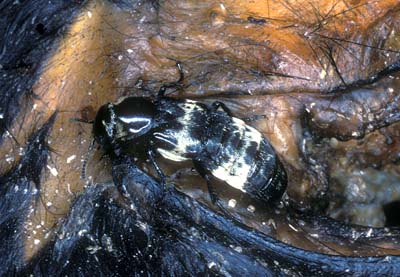
Adult Creophilus maxillosus, a rove beetle.
(Photographer: James E. Lloyd, University of Florida)
Adult male and female rove beetles range in size from 1 mm to 25 mm in length, but the length for most species is about 0.7 cm. Most rove beetles have slender, flexible, flattened, muscular bodies with short forewings (elytra) which are rectangular at the tips. Other rove beetles may possess a broader body shape with forewings (elytra) covering most of the abdomen. The antennae may be simple, elbowed, or clubbed. The color pattern of most rove beetles ranges from reddish-brown to black. The legs are colored similar to the body. Rove beetle eggs are white, spherical or pear-shaped. The larvae are slender bodied and vary in color. Pupae of most rove beetles are white, but some are slightly pigmented and have a hardened exterior.
Rove beetles breed throughout the year and the adults are long-lived. Depending upon the species, their life cycles vary from a few days to a few weeks.
Rove beetles are night hunters that live in moist habitats throughout the United States, especially where there is decaying animal or plant material. Rove beetles feed on many different types of fly eggs and larvae.
Images
To save the Web-optimized images shown below to your hard drive:
|
Click to access Display and Print quality images. |
|
Click to access Display and Print quality images. |